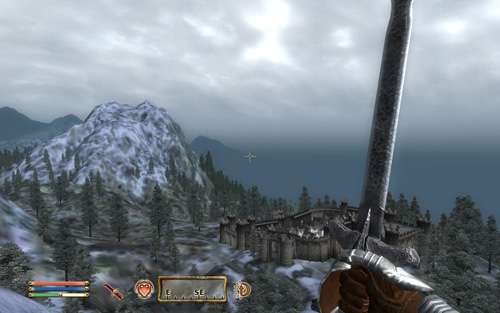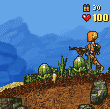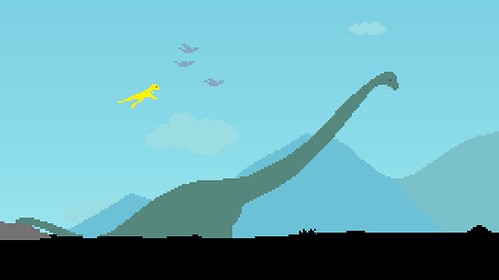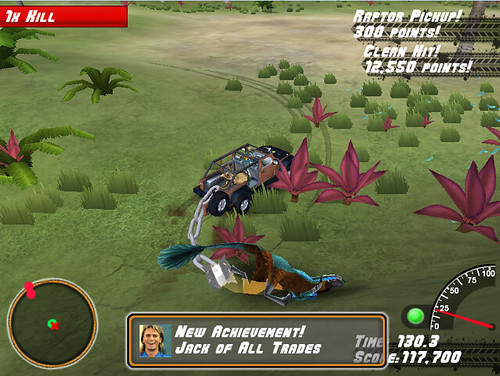
This post is going to try and do a couple of things. Firstly, it’s a (very) short summary of the first half of Gonzalo Frasca’s essay “Simulation vs. Narrative”. Secondly, after explaining the ideas contained in Frasca’s paper, I hope to convince my good friend Xenia (the wife of one of my best friends, and a genuine friend of mine in her own right) that the videogame Super Columbine Massacre RPG is not the result of a sick and perverted mind, but instead a serious and thoughtful attempt to come to grips with the whole, messy, horrible situation. Thirdly, I’m going to try and apply a couple of Frasca’s ideas to the videogame Oblivion and suggest an explanation for why another of my good friends, Michael Abbot over at The Brainy Gamer, didn’t enjoy Oblivion as much as he should have (or maybe if I’m being more honest, could have. In the interest of Full Disclosure: I really like Oblivion in all it’s half-baked glory.)
Frasca opens his paper saying that “So far, the traditional –and most popular– research approach from both the industry and the academy has been to consider video games as extensions of drama and narrative.” Frasca also states that:
Representation is such a powerful and ubiquitous form that it has become transparent to our civilization. …This is especially true with a particular form of structuring representation: narrative
He argues that by its ubiquity it has become almost transparent to us and that we actually have a very hard time accepting “that there is an alternative to representation and narrative: simulation.” Frasca provides some very excellent examples of where simulation is present outside of computation: in children’s play, when a toy plane becomes a plane (even a story is created about the plane, the game is still simulating a plane) as well as in Governmental legislation. But I’m getting ahead of myself. What exactly makes something a simulation? Frasca says that
to simulate is to model a (source) system through a different system which maintains to somebody some of the behaviors of the original system.
Returning to our examples of a child at play – the toy plane is modelling the behaviour of a real plane – while it may not actually fly, when the child is whooshing it though the air, to him or her it may as well be. The ‘to somebody’ part of Frasca’s definition in this case is obviously the child – someone not engaged in the simulation (which incidentally may be running only in his or her head, but might also equally be shared by a playmate) the toy remains only that - a toy. To contrast this idea and demonstrate its difference from narrative – Frasca says that
A film about a plane landing is a narrative: an observer could interpret it in different ways (i.e. “it’s a normal landing” or “it’s an emergency landing”) but she cannot manipulate it and influence on how the plane will land since film sequences are fixed and unalterable. On the other hand, the flight simulator allows the player to perform actions that will modify the behavior of the system in a way that is similar to the behavior of the actual plane.
The previous example of the government legislator is somewhat different again, and it shows that the notion of authorship of simulation is quite different to authorships of narrative. A government legislator when writing a new series of laws or by-laws is not explicitly authoring the story of the single working mother who may now be safe from exploitation by her boss as a result of the new law, and yet that story may indeed arise from it. Instead, the law maker is authoring rules as part of the society’s system and the stories (or narratives) that arise from the rules remain a largely unknown consequent.
To return to the point about the difficulty in acknowledging the difference of simulation from narrative, Frasca says that
To an external observer, the sequence of signs produced by both the film and the simulation could look exactly the same. This is what many supporters of the narrative paradigm fail to understand: their semiotic sequences might be identical, but simulation cannot be understood just through its output.
That is, a flight simulator cannot be judged and evaluated as a simulation by simply watching it run – the experience of controlling the simulation is entirely different from the one of watching it – and this is an extremely important point as it has implications for videogame representations.
To turn my attention to the second point, many people when told of the existence of a Super Columbine Massacre RPG game are shocked, disgusted or even outraged, and I think largely because, as a society, we have little to no experience with having to deal with shocking images and situations unless it is presented as a narrative. The disconnect between a persons actions and a persons beliefs, cognitive dissonance even, is perhaps not possible outside of simulations like videogames. When reading a book about the holocaust, one does not feel complicit in the actions of the Nazi’s at Auschwitz, even when recounted in a novel from a personal perspective.
So let me ask you this: A person would be less likely to respond like the one mentioned above if it was instead a thoughtful, reasoned novel that attempted to examine and explain the tragedy of the columbine high school massacre, correct? Well, perhaps someone would, and that would be a valid reaction, potentially based in a general unease with trying to identify with the two killers – Eric and Dylan. But the objection would likely not be to the fact that there was a book about it, but rather the content of the book. So why then, does just the idea of a videogame about the events of Tuesday, April 20th 1999 provoke such consternation?
The answer is far from as simple as I am proposing, as numerous other legitimate, real factors come into play, however I am of the inclination that it is because many people do not have the requisite experience with simulation, and indeed with engaging seriously with simulational media, that is required to accept and understand the reasoning behind creating something like Super Columbine Massacre RPG. Frasca says that indeed ‘Video games imply an enormous paradigm shift for our culture because they represent the first complex simulational media for the masses’. I guess what I would like every reader to understand is that, far from being designed for the glorification of the shooters themselves, the game is part of what can be described as the ‘the search for rationale’ in much the same way as any book or film about the subject, however instead of employing a narrative to make his point, the creator Danny Ledone decided to use a simulation – and that leaves people without the experience in disconnecting their actions in a simulation from their beliefs, quite understandably uneasy.
Sadly, I personally feel that, while an excellent effort and a great start, Super Columbine Massacre RPG does not succeed in its efforts but not through any fault of the medium. Without getting into an in depth critique of the game, it suffers from much of the same failings as many big budget videogames, such as Oblivion, which I have written about on the blog previously. Let me explain by saying that, if we take Frasca’s view, and that games are indeed simulations, then the vast majority of the source systems videogames are modelling (and I cannot stress this point enough) are narratives! Super Columbine Massacre RPG deploys Role Playing Game tropes and contentions but fails to escape the trap of trying to model a linear, progressive narrative story.
The Elder Scrolls IV: Oblivion is similarly an RPG and I believe falls into exactly the same trap. My good friend from the other side of the planet, Michael Abbott, failed to find Oblivion enjoyable for a number of reasons, among which the fact that he ‘just got bored’ and stopped enjoying the game. I propose that, similar to Super Columbine, Oblivion tried to render, intentionally or not, a narrative as their source simulation; however, I also believe that they had a conflicting desire to simulate a world (a distinctly non narrative thing)– a fact that is evident in much of the free-form structure of the game. If the developers of Oblivion had of concentrated on modelling a consistent world and, dare I suggest, left out entirely the narrative elements like the main storyline instead focussing on emergent possibilities – perhaps by finetuning the ‘Radiant AI’ system which gave each non-player character such things as motivations, desires and habits and then made them go about their business to satisfy these conditions – then I genuinely think the game would have been both extremely different and more attractive to some certain players. Now, I’m not 100% confident of this evaluation, but based on comments made by Michael and others, such as that ‘the NPC’s were very boring’ (a valid assessment – they were very generic) then perhaps by dropping the (I suggest crippling) overarching need to model a narrative, Oblivion would have been significantly better – there would still have been significant challenges to overcome to realise this ideal, but overall I think the point still stands.
In summing up, let me return, once again to Frasca who points to suggestions by proponents of Interactive Narrative that “Aristotelian closure” is the source of ‘the user’s pleasure’. He says that ‘The biggest fallacy of “interactive narrative” is that it pretends to give freedom to the player while maintaining narrative coherence’. Frasca says that instead
the gratification for [participants in simulation] is not the one of the professional actor but rather the one of the child who plays make-believe. The child is constantly adapting fantasy to different changes, without the grown-ups obsession with closure.
As an interesting comparison, think of the difference between something like Hamlet and your typical game of Theatresports – the former is a narrative, and any attempts to incorporate interactivity would probably compromise its narrative coherence, whereas the latter, if constrained by a script, loses all of the charm and attractiveness derived from its spontaneity. The difference between simulation and narrative is a wide and often mis-understood (even at times mischaracterised) chasm, but one which remains largely uncharted. Let’s start today – I’m game, are you?













